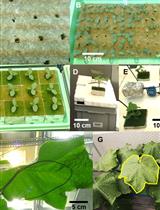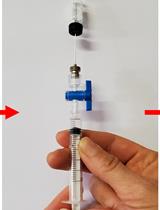- Submit a Protocol
- Receive Our Alerts
- EN
- EN - English
- CN - 中文
- Protocols
- Articles and Issues
- For Authors
- About
- Become a Reviewer
- EN - English
- CN - 中文
- Home
- Protocols
- Articles and Issues
- For Authors
- About
- Become a Reviewer
Plant Materials and Growth Conditions of Japanese Morning Glory (Ipomoea nil cv. Violet)
Published: Vol 5, Iss 10, May 20, 2015 DOI: 10.21769/BioProtoc.1478 Views: 10211
Reviewed by: Tie LiuYuko Kurita

Protocol Collections
Comprehensive collections of detailed, peer-reviewed protocols focusing on specific topics
Related protocols

Experiments for in silico evaluation of Optimality of Photosynthetic Nitrogen Distribution and Partitioning in the Canopy: an Example Using Greenhouse Cucumber Plants
Yi-Chen Pao [...] Hartmut Stützel
Mar 20, 2020 4361 Views

Accelerated Snowmelt Protocol to Simulate Climate Change Induced Impacts on Snowpack Dependent Ecosystems
Laura T. Leonard [...] Jonathan O. Sharp
Mar 20, 2020 3383 Views

Quantification of Ethylene Production in Leaf and Bud Tissue of the Subtropical Tree Crop Litchi (Litchi chinensis Sonn.) Using Gas Chromatography and Flame Ionization Detection
Regina B. Cronje and Arnoldus J. Jonker
Mar 20, 2023 421 Views
Abstract
Japanese morning glory (Ipomoea nil) is a summer annual vine that typically produces ephemeral flowers. This plant has been used extensively to investigate flowers, including studies on flowering, flower color, and petal senescence. Here we describe the materials and optimal growth conditions used to grow the Japanese morning glory cultivar, “Violet”, in a growth chamber. Violet plants are transformable with Agrobacterium (Rhizobium), and we have used this cultivar to examine petal senescence (Shibuya et al., 2009; Shibuya et al., 2014).
Keywords: Morning gloryBackground
Materials and Reagents
- Japanese morning glory cultivar, “Violet” (Ipomoea nil cv. Violet) seeds
Note: Seeds of the Japanese morning glory cultivar, “Violet” (Ipomoea nil cv. Violet), as well as other cultivars can be obtained through the National BioResource Project, Japan (http://www.shigen.nig.ac.jp/asagao/).
- Horticultural soil (Nippi Horticulture soil No. 1; Nihon Hiryo)
- Fertilizer (Hyponex, catalog number: 15-30-15 )
Equipment
- Growth chamber
- 12 cm-diameter pots
- Metal wire (1 m)
- Utility knife
Procedure
- Soil preparation
- We use a granular horticultural soil with fertilizer (Nippi Horticulture soil No. 1) but most types of horticultural soil for flowers or vegetables can be used to grow Japanese morning glory.
- Place the soil into pots; we use 12 cm-diameter pots with a hole in the bottom. The hole is covered with a net to prevent the loss of soil, and the soil is moistened.
- We use a granular horticultural soil with fertilizer (Nippi Horticulture soil No. 1) but most types of horticultural soil for flowers or vegetables can be used to grow Japanese morning glory.
- Seed preparation
Shave off a thin slice of the seed coat opposite the embryo with a knife to increase imbibition (Figure 1), taking care not to make the incision too deep. If you see the white underlying endosperm, then the depth of the incision is sufficient. This procedure ensures that the time required to germination is more uniform.

Figure 1. A Violet seed with a thin slice of the seed coat removed. E, Embryo; *area of shaved seed coat
- Planting
- Plant the prepared seeds in soil at a depth of 1-1.5 cm (one seed per pot).
- To grow the Violet plants, place the pots on a tray.
- The tray containing the pots is then placed in a growth chamber at 24 °C and a relative humidity of 70%. The photoperiod used is 16L/8D (light/dark) with light provided by white-fluorescent lamps at approximately 100 µmol/m/s. Plants typically germinate after 3-4 days.
- Plants are grown for 1 month under the 16L/8D long-day photoperiod.
- Plants are fertilized with 1 g/L Hyponex 15-30-15 (150-200 ml per pot) once a week after the first true leaf expands.
Notes:
- There are unlikely to be any pests in a clean growth chamber. However, if whiteflies are problem, scatter granular “Orthoran” on the soil surface after germination.
- We pinch the tip of vine to induce axillary bud formation when the plants have five true leaves (Figure 2), but this procedure is not essential for flower production.

Figure 2. A drawing of the Violet plant with five true leaves. An arrow indicates a position for pinching out the vine.
- There are unlikely to be any pests in a clean growth chamber. However, if whiteflies are problem, scatter granular “Orthoran” on the soil surface after germination.
- Wind the developing vines around a support. We use metal wire as a support (Figure 3).
- After 1 month, change the photoperiod to a 12L/12D cycle to induce flowering.
Note: The Japanese morning glory is an absolute short-day plant. If you want to produce flowers more quickly, place the pots under a photoperiod of 12L/12D from the very beginning (i.e. immediately after sowing). If you want to induce the production of larger plants with more flowers, grow the plants under a long-day photoperiod (16L/8D) for more than 1 month.
- The plants should produce flower buds approximately 1 month after the photoperiod is changed to the 12L/12D cycle (Figure 3).
Notes:
- If the flowers are removed before the seeds are set (preferably, before the flowers wilt) then the plants will keep flowering for several months as seed setting markedly increases plant death.
- Under a photoperiod of 12L/12L, the flowers will be almost fully open at the start of the light period.
- If you want to harvest seeds, mature seeds can be obtained approximately 6 weeks after the flowers open.

Figure 3. A Violet plant after 11 weeks in a growth chamber - If the flowers are removed before the seeds are set (preferably, before the flowers wilt) then the plants will keep flowering for several months as seed setting markedly increases plant death.
- Plant the prepared seeds in soil at a depth of 1-1.5 cm (one seed per pot).
Acknowledgments
This work was supported by grants from the National Agriculture and Food Research Organization, Japan. We thank the National BioResource Project, Japan for providing seeds of Japanese morning glory cultivar, “Violet”.
References
- Shibuya, K., Shimizu, K., Niki, T. and Ichimura, K. (2014). Identification of a NAC transcription factor, EPHEMERAL1, that controls petal senescence in Japanese morning glory. Plant J 79(6): 1044-1051.
- Shibuya, K., Yamada, T., Suzuki, T., Shimizu, K. and Ichimura, K. (2009). InPSR26, a putative membrane protein, regulates programmed cell death during petal senescence in Japanese morning glory. Plant Physiol 149(2): 816-824.
Article Information
Copyright
© 2015 The Authors; exclusive licensee Bio-protocol LLC.
How to cite
Shibuya, K. (2015). Plant Materials and Growth Conditions of Japanese Morning Glory (Ipomoea nil cv. Violet). Bio-protocol 5(10): e1478. DOI: 10.21769/BioProtoc.1478.
Category
Plant Science > Plant physiology > Plant growth
Do you have any questions about this protocol?
Post your question to gather feedback from the community. We will also invite the authors of this article to respond.
Tips for asking effective questions
+ Description
Write a detailed description. Include all information that will help others answer your question including experimental processes, conditions, and relevant images.
Share
Bluesky
X
Copy link







